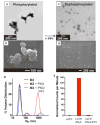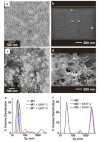Controlling and switching the morphology of micellar nanoparticles with enzymes
- PMID: 21462979
- PMCID: PMC3756928
- DOI: 10.1021/ja2004736
Controlling and switching the morphology of micellar nanoparticles with enzymes
Abstract
Micelles were prepared from polymer-peptide block copolymer amphiphiles containing substrates for protein kinase A, protein phosphatase-1, and matrix metalloproteinases 2 and 9. We examine reversible switching of the morphology of these micelles through a phosphorylation-dephosphorylation cycle and study peptide-sequence directed changes in morphology in response to proteolysis. Furthermore, the exceptional uniformity of these polymer-peptide particles makes them amenable to cryo-TEM reconstruction techniques lending insight into their internal structure.
Figures




Similar articles
-
Metalated diblock and triblock poly(ethylene oxide)-block-poly(4-vinylpyridine) copolymers: understanding of micelle and bulk structure.J Phys Chem B. 2005 Oct 13;109(40):18786-98. doi: 10.1021/jp053333x. J Phys Chem B. 2005. PMID: 16853418
-
Monolayer-protected gold nanoparticles by the self-assembly of micellar poly(ethylene oxide)-b-poly(epsilon-caprolactone) block copolymer.Langmuir. 2007 Feb 13;23(4):2126-32. doi: 10.1021/la0627563. Langmuir. 2007. PMID: 17279704
-
Morphology transformation of hybrid micelles self-assembled from rod-coil block copolymer and nanoparticles.Langmuir. 2012 Mar 6;28(9):4515-24. doi: 10.1021/la204941w. Epub 2012 Feb 17. Langmuir. 2012. PMID: 22299635
-
Enzyme-Responsive Nanoparticles for Targeted Accumulation and Prolonged Retention in Heart Tissue after Myocardial Infarction.Adv Mater. 2015 Oct 7;27(37):5547-52. doi: 10.1002/adma.201502003. Epub 2015 Aug 25. Adv Mater. 2015. PMID: 26305446 Free PMC article.
-
Smart organic-inorganic nanohybrids based on amphiphilic block copolymer micelles and functional silsesquioxane nanoparticles.Langmuir. 2009 Apr 9;25(6):3407-17. doi: 10.1021/la803601a. Langmuir. 2009. PMID: 19708139
Cited by
-
Enzyme-directed assembly of a nanoparticle probe in tumor tissue.Adv Mater. 2013 Jul 12;25(26):3599-604. doi: 10.1002/adma.201300823. Epub 2013 May 28. Adv Mater. 2013. PMID: 23712821 Free PMC article.
-
Enzyme-directed assembly of nanoparticles in tumors monitored by in vivo whole animal imaging and ex vivo super-resolution fluorescence imaging.J Am Chem Soc. 2013 Dec 18;135(50):18710-3. doi: 10.1021/ja408182p. Epub 2013 Dec 5. J Am Chem Soc. 2013. PMID: 24308273 Free PMC article.
-
Exploring Emergent Properties in Enzymatic Reaction Networks: Design and Control of Dynamic Functional Systems.Chem Rev. 2024 Mar 13;124(5):2553-2582. doi: 10.1021/acs.chemrev.3c00681. Epub 2024 Mar 4. Chem Rev. 2024. PMID: 38476077 Free PMC article. Review.
-
Local detection of pH-induced disaggregation of biocompatible micelles by fluorescence switch ON.Chem Sci. 2022 Mar 10;13(17):4884-4892. doi: 10.1039/d2sc00304j. eCollection 2022 May 4. Chem Sci. 2022. PMID: 35655864 Free PMC article.
-
Enzymatic transformation of phosphate decorated magnetic nanoparticles for selectively sorting and inhibiting cancer cells.Bioconjug Chem. 2014 Dec 17;25(12):2129-33. doi: 10.1021/bc500516g. Epub 2014 Dec 4. Bioconjug Chem. 2014. PMID: 25431967 Free PMC article.
References
-
- Torchilin VP. Coll Surf B. 1999;16:305–319.
- Shanmugananda Murthy K, Ma Q, Clark CG, Remsen EE, Wooley KL. Chem Commun. 2001:773–774.
- Hamley IW. Angew Chem, Int Ed. 2003;42:1692–1712. - PubMed
- Alarcon CdlH, Pennadam S, Alexander C. Chem Soc Rev. 2005;34:276–285. - PubMed
- Gothelf KV, LaBean TH. Org Biomol Chem. 2005;3:4023–4037. - PubMed
- Nayak S, Lyon LA. Angew Chem, Int Ed. 2005;44:7686–7708. - PubMed
- Petrak K. Drug Disc Today. 2005;10:1667–1673. - PubMed
- Vasir JK, Reddy MK, Labhasetwar VD. Curr Nanosci. 2005;1:47–64.
- Hawker CJ, Wooley KL. Science. 2005;309:1200–1205. - PubMed
- Mastrobattista E, van der Aa Marieke AEM, Hennink Wim E, Crommelin Daan JA. Nat Rev Drug Discov. 2006;5:115–121. - PubMed
- Na K, Sethuraman VT, Bae YH. Anti-Canc Agents Med Chem. 2006;6:525–535. - PubMed
- Alemdaroglu FE, Herrmann A. Org Biomol Chem. 2007;5:1311–1320. - PubMed
- Peer D, Karp JM, Hong S, Farokhzad OC, Margalit R, Langer R. Nat Nanotechnol. 2007;2:751–760. - PubMed
- Smith D, Pentzer EB, Nguyen ST. Pol Rev. 2007;47:419–459.
- Ganta S, Devalapally H, Shahiwala A, Amiji M. J Cont Release. 2008;126:187–204. - PubMed
- Du J, O'Reilly RK. Soft Matter. 2009;5:3544–3561.
- Meng F, Zhong Z, Feijen J. Biomacromolecules. 2009;10:197–209. - PubMed
-
- Sawyers CL. Nature. 2008;452:548–552. - PubMed
- Vartak DG, Gemeinhart RA. J Drug Targ. 2007;15:1–20. - PMC - PubMed
- Raffetto JD, Khalil RA. Biochem Pharm. 2008;75:346–359. - PMC - PubMed
- Kessenbrock K, Plaks V, Werb Z. Cell. 2010;141:52–67. - PMC - PubMed
- Liotta LA, Tryggvason K, Garbisa S, Hart I, Foltz CM, Shafie S. Nature. 1980;284:67–68. - PubMed
- Davies B, Waxman J, Wasan H, Abel P, Williams G, Krausz T, Neal D, Thomas D, Hanby S, Balkwill F. Cancer Res. 1993;53:5365–5369. - PubMed
- MacDougall JR, Bani MR, Lin Y, Muschel RJ, Kerbel RS. Br J Cancer. 1999;80:504–512. - PMC - PubMed
- MacDougall JR, Bani MR, Lin Y, Rak J, Kerbel RS. Cancer Res. 1995;55:4174–4181. - PubMed
- Jinga DC, Blidaru A, Condrea I, Ardeleanu C, Dragomir C, Szegli G, Stefanescu M, Matache C. J Cell Mol Med. 2006;10:499–510. - PMC - PubMed
- Maatta M, Santala M, Soini Y, Turpeenniemi-Hujanen T, Talvensaari-Mattila A. Acta Obstet Gynecol Scand. 2010;89:380–384. - PubMed
-
- Israelachvilli JN, Mitchell DJ, Ninham BW. J Chem Soc, Faraday Trans 2. 1976;72:1525–1568.
- Tanford C. The Hydrophobic Effect: Formation of Micelles and Biological Membranes. Second. John Wiley & Sons, Inc; New York: 1980.
- Matsen MW, Bates FS. Macromolecules. 1996;29:7641–7644.
- Discher BM, Won YY, Ege DS, Lee JCM, Bates FS, Discher DE, Hammer DA. Science. 1999;284:1143–1146. - PubMed
- Nagarajan R. Langmuir. 2002;18:31–38.
- Jain S, Bates FS. Science. 2003;300:460–464. - PubMed
- Smart T, Lomas H, Massignani M, Flores-Merino MV, Perez LR, Battaglia G. Nano Today. 2008;3:38–46.
-
- Zhang L, Yu K, Eisenberg A. Science. 1996;272:1777–1779. - PubMed
- Bendejacq D, Ponsinet V, Joanicot M. Langmuir. 2005;21:1712–1718. - PubMed
- LaRue I, Adam M, Pitsikalis M, Hadjichristidis N, Rubinstein M, Sheiko SS. Macromolecules. 2006;39:309–314.
- Buetuen V, Liu S, Weaver JVM, Bories-Azeau X, Cai Y, Armes SP. React Funct Pol. 2006;66:157–165.
- Lee HI, Wu W, Oh JK, Mueller L, Sherwood G, Peteanu L, Kowalewski T, Matyjaszewski K. Angew Chem, Int Ed. 2007;46:2453–2457. - PubMed
- Ishihara Y, Bazzi HS, Toader V, Godin F, Sleiman HF. Chem Euro J. 2007;13:4560–4570. - PubMed
- Rijcken CJF, Soga O, Hennink WE, van Nostrum CF. J Cont Rel. 2007;120:131–148. - PubMed
- Nakayama M, Okano T. Macromolecules. 2008;41:504–507.
- Sundararaman A, Stephan T, Grubbs RB. J Am Chem Soc. 2008;130:12264–12265. - PubMed
- Klaikherd A, Nagamani C, Thayumanavan S. J Am Chem Soc. 2009;131:4830–4838. - PMC - PubMed
- Roy D, Cambre JN, Sumerlin BS. Chem Commun. 2009:2106–2108. - PubMed
- Wang YC, Tang LY, Li Y, Wang J. Biomacromolecules. 2009;10:66–73. - PubMed
- Moughton AO, O'Reilly RK. Chem Commun. 2010;46:1091–1093. - PubMed
- Agut W, Brulet A, Schatz C, Taton D, Lecommandoux S. Langmuir. 2010;26:10546–10554. - PubMed
- Chien MP, Rush AM, Thompson MP, Gianneschi NC. Angew Chem Int Ed. 2010;49:5076–5080. - PMC - PubMed
Publication types
MeSH terms
Substances
Grants and funding
LinkOut - more resources
Full Text Sources
Other Literature Sources

